Some of us took advantage of this cool rainy afternoon to view the battlefield that marked the end of an effort to create a “European union”—the battlefield where Napoleon (if you remember the 50s song) met his Waterloo. I did not realize it was close to Brussels, but it’s less than 10 miles outside the city; being a fan of short megalomaniacs, I had to go see it.
When Napoleon escaped from Elba, and rallied his soldiers, he thought he might have a chance at splitting the coalition reunited against him if he  struck a quick blow. At Waterloo, he tried to keep the Prussian and Anglo-Dutch armies from uniting against him. Slowed by rain (imagine that!), in June 1815, his armies struck too late to prevent the Prussians from joining
struck a quick blow. At Waterloo, he tried to keep the Prussian and Anglo-Dutch armies from uniting against him. Slowed by rain (imagine that!), in June 1815, his armies struck too late to prevent the Prussians from joining 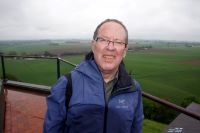 with Wellington, and, according to the movie, allowed Wellington’s armies to gather where they could not be destroyed by French artillery. In a 10 hour battle, around 170,000 troops decided the fate of Napoleonic France.
with Wellington, and, according to the movie, allowed Wellington’s armies to gather where they could not be destroyed by French artillery. In a 10 hour battle, around 170,000 troops decided the fate of Napoleonic France.
In a sense, the battle underscores what we’ve been learning in Brussels—the difficulty of unifying Europe short of war. That’s the message we’re taking from our visits to members of the European Union civil service staff—the people most committed to making “Europe” work. For example, yesterday’s speaker raised a point I had not considered—a simple but complex one involving the basis of legal codes. While the British have evolved common law (it’s common to us, too), much of Europe uses the Code Napoleon. As I noted to the speaker, Louisiana uses the Code Napoleon in the US, which should give Europeans hope that the legal systems can actually mesh. His comment: “the EU is ahead of its time.”
Today’s speaker gave a slightly different view of the origins of the European Union that helped me understand some of its functioning. I think he described the evolution in terms of “shared sovereignty”—in which the members have given up authority over certain areas, and created an organizational structure to oversee laws in those areas. In other words, if the treaties have conceded pollution controls to a “High Authority” (as the European Commission was once known), the legislation Parliament passes on that topic is enforceable in all countries—whether they voted for it or not. His comment was that it is an unprecedented “experiment.” When he noted it has been going on for 60 years, my response was that after 60 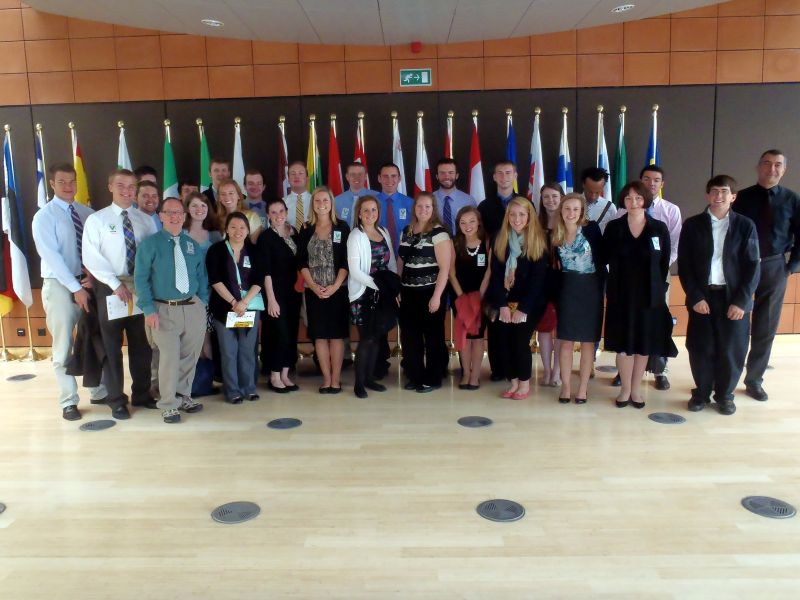 years, the United States had not yet sorted out many of the issues that “We the People” wrote a constitution to settle; I hoped it doesn’t take a civil war to resolve Europe’s issues.
years, the United States had not yet sorted out many of the issues that “We the People” wrote a constitution to settle; I hoped it doesn’t take a civil war to resolve Europe’s issues.
One other thing we’re taking from our EU visits is the focus of the European Union on social issues—and more general r&d support. I remember from my last trip in Eastern Europe that much of the infrastructure support for roads, for example, in the Baltic countries, came from EU support. In addition, one of our speakers in Paris was a Ph.D. (from Illinois) working on a project involving DNA, that was based on a 7 billion Euro grant. Think about an American working on pure research in Europe….
If you want a business epigram on why the EU needs to continue to exist—when I left London, I had not spent or exchanged all my British pounds. I took a 20 pound note to the exchange, worth about 31$ and got back (after fees and commission) about 15 Euro, or about 21$. Imagine doing that every time you crossed a border!
As for Brussels itself, home to NATO as well as the EU, cold wet days are not uncommon—and they are ideal for spending time in museums, which we’ve also done. My three favorites included two as impressive for the buildings as for the contents—the buildings were art nouveau, and the museums helped spare the wrecking ball. One was a comic strip museum—after all the adventurous Tintin came from the brush of a Belgian artist—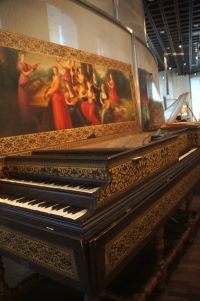 who has been translated in dozens of languages around the world. The second museum of note was the Musical Instruments Museum, housed in a former Art Nouveau department store. When I entered, I was given an audio guide; as I passed the exhibits, the instrument featured played. If you’ve never heard a cabinet organ, you’ve missed a real treat, as I would have had I not gone to the museum. The third museum is on the grand place, a medieval square I mentioned yesterday, with Gothic and Baroque homes. Professor Pana and I went to the “House of the King,” which was a wonderful Gothic building with period pieces, art, sculpture, and pictures of the city, some of them following Louis XIV bombardment that leveled 4000 houses.
who has been translated in dozens of languages around the world. The second museum of note was the Musical Instruments Museum, housed in a former Art Nouveau department store. When I entered, I was given an audio guide; as I passed the exhibits, the instrument featured played. If you’ve never heard a cabinet organ, you’ve missed a real treat, as I would have had I not gone to the museum. The third museum is on the grand place, a medieval square I mentioned yesterday, with Gothic and Baroque homes. Professor Pana and I went to the “House of the King,” which was a wonderful Gothic building with period pieces, art, sculpture, and pictures of the city, some of them following Louis XIV bombardment that leveled 4000 houses.
Well, we leave Brussels for Berlin via Cologne with good memories of 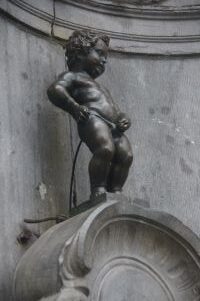 Brussels—the Manneken-Pis (look that one up; it’s the symbol of the city); the chocolate (world famous!), and lapin (rabbit) and moule (mussels) meals. That moule meal was facilitated by an IWU alum, George Kambouroglou, who works as a software supervisor at the EU. We’ve been in touch with George as soon as we learned he was in Brussels, and the ’93 graduate of IWU bent over backward to make sure we had as
Brussels—the Manneken-Pis (look that one up; it’s the symbol of the city); the chocolate (world famous!), and lapin (rabbit) and moule (mussels) meals. That moule meal was facilitated by an IWU alum, George Kambouroglou, who works as a software supervisor at the EU. We’ve been in touch with George as soon as we learned he was in Brussels, and the ’93 graduate of IWU bent over backward to make sure we had as 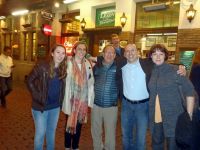 much information as he could find, and, even though he left with his family for the US this morning, joined us for dinner last night at Café Leon to reminisce about his days as an Acacia/physics major at IWU.
much information as he could find, and, even though he left with his family for the US this morning, joined us for dinner last night at Café Leon to reminisce about his days as an Acacia/physics major at IWU.
On to Berlin.